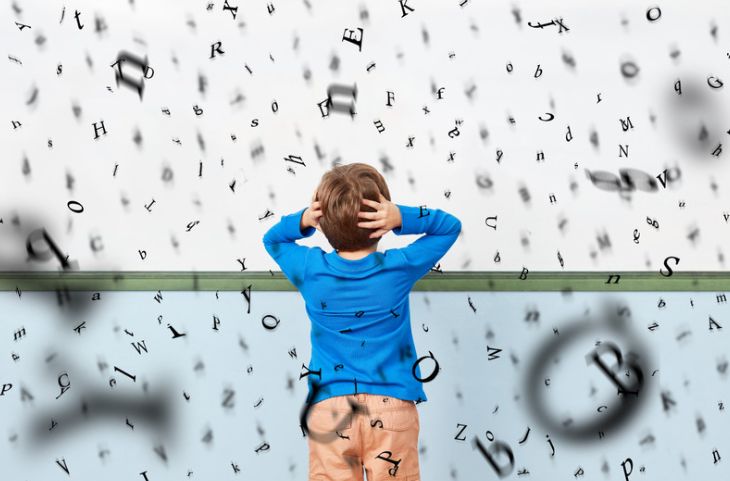Many still make the mistake of thinking that dyslexia is a learning disability that results from low intelligence, but nothing could be further from the truth. In fact, people with dyslexia often have excellent spatial orientation, the ability to think outside the box and high emotional intelligence, but this is a problem that must be addressed in children, among other things because it may have a negative effect on academic achievements and the child's feeling towards himself. Therefore, every parent should get to know this subject beyond the superficial level, and also learn how to identify dyslexia in their children and what they should do to help them succeed in school and in life despite the difficulty that the disability poses.
The 4 main types of dyslexia
Dyslexia is a learning disability that has different shades, and children who suffer from it can have difficulty with reading comprehension, spelling, writing, etc. It is estimated that 5-10% of the population suffers from dyslexia of one kind or another, with some even claiming that up to 17% of the population suffers from this learning disability. There is no one official division that the research community has reached an absolute agreement about, but the following division is the most accepted today and is based on the symptoms of the disability and their possible explanations:

1. Phonological dyslexia
This type of dyslexia appears at a very early stage, even when the child is a toddler, and it manifests itself in difficulties with speech, verbal formulation and a small vocabulary. At an older age, this already manifests itself in difficulty deciphering sounds and using reading and spelling skills that have already been acquired, or also in difficulties in spelling in general or in creating cumbersome formulations. The problem here is the inefficiency of the phonological processing processes in the brain when there is difficulty in recognizing sounds that are played quickly one after the other, which makes it difficult to understand the spoken language. You may not see the difficulty in a one-on-one conversation, but you will when you try to have a conversation in a noisy environment.
2. Lexical dyslexia
This type manifests itself in the difficulty of turning a new written word into an understandable word and difficulty in remembering spelling, which is often also expressed in dysgraphia. The problem here is in the lexical processes, which require the reader to recognize the word in its entirety without trying to pronounce each letter in it separately, based on familiarity with the word. This handicap becomes even more obvious when the child comes across words he knows but does not understand the context in which they were written, thus he will have difficulty recognizing them.
3. Visual dyslexia
This dyslexia is rooted in the idea that reading a text is a process that is based on visual scanning - looking at the words and short jumping movements of the eyes to the next line. At a young age, this will be manifested, among other things, in the difficulty of distinguishing between letters and the background behind them, difficulties in focusing the gaze on a specific point and remembering the general appearance of words, focusing on each letter when reading a new word and confusion between similar letters that have only a directional visual difference (like the letters b and d in English). Reading requires a lot of effort, and the reader may even suffer from a migraine in the back of the brain due to that effort, due to the expansion of blood vessels around the optic lobe.
4. Combined dyslexia
It's dyslexia that combines two or more of the other types, with the different types of dyslexia influencing each other and depending on each other. The reason why the classification of dyslexia into 4 types is not accepted by all researchers is that the independent existence of visual dyslexia is not clear, and some speculate that every person who suffers from visual dyslexia also suffers from phonological dyslexia. They explain this with difficulty in fast data processing, which leads to a superficial understanding of parts of speech and syllables, and this may also manifest itself in visual or even motor information processing processes. The reinforcement given to this explanation is the difficulty in estimating the time that many of those who deal with dyslexia suffer from.

How to identify dyslexia in children
This disability is congenital and its origin is neurological, but it may also arise due to brain damage (accident, stroke, etc.). It can pass through the genes, resulting from premature birth, low birth weight, infections during pregnancy that damaged the brain development of the fetus or exposure of the fetus to substances such as nicotine, alcohol and drugs. This problem worsens over time, but early detection may help children develop different learning methods and even improve their condition. You can see the symptoms from preschool age, and even if you didn't recognize the disability in time, it has additional signs in the school and high school age stages:
Signs of dyslexia in kindergarten:
- Delay in speech development.
- Difficulty remembering letters and colors.
- Using words that are not correct, reversing sounds or confusing similar-sounding words.
Signs of dyslexia at school and middle school age:
- Speech difficulties - the child may read more slowly than the rest of his class.
- Difficulties in processing information and remembering
- Slow writing.
- Difficulty pronouncing new words or processing words with similar sounds.
- Avoiding assignments that require reading.
Signs of dyslexia in high school and adulthood:
- Slow execution of the processing and summarizing processes of reading or written material.
- Spelling difficulties and learning new words.
- Incorrect pronunciation of words.
- Difficulty remembering text.
- Difficulty dealing with math exercises.
- Difficulty reading aloud.
- Difficulty in telling a story.
- Handwriting is not clear, legible or organized.
- Low grades.

How to help a child suffering from dyslexia?
The first and most important thing is to identify the problem early, and you have already received the tools to help you with this, but if you suspect that your child does suffer from such a learning disability, it is recommended to seek a professional diagnosis. If there is indeed a problem, you will have to inform the educational staff so that they can create a curriculum for him that suits him and his abilities.
But all this may not enough, and beyond that, there are also things you can do at home and in everyday life that will help strengthen your child's self-confidence and show him how to fight the difficulties he faces. It is not easy, and you must maintain a regular routine of doing schoolwork at home and find tools that will help your child so that you can indeed set him up for success, but don't forget that you will also have to show a lot of love, support and patience.
1. Reading training
Every child is different, and everyone has different ways of learning. There is no perfect recipe, but it always requires a lot of training, regular routine and support. That is why you must sit with your child and read together with him - a lot! There are many ways to do this, and you will have to find the ones that suit your child according to his strengths and weaknesses:
- Reading to a child or listening to books being read while he is also reading a book, so that the child will read along with the narrator.
- Reading alone - silently and aloud. It is even recommended that you sit next to your child while he is doing this and read your own book, or that you read books just like that during the day, in order to be a role model for him.
- Re-reading books he has read in the past, together with you. It might bore you a little after a while, but it is essential for the child.
- Reading aloud and taking turns - sometimes you and sometimes the child.
- While you are reading you can stop and ask questions about the story, for example: "What do you think the hero will do now?"
- Incorporate into your routine also graphic stories, comics and in general stories that will excite and interest your child.
2. Tools for doing school assignments
Do not be afraid to allow your child to integrate the technology that exists today in his learning processes - these are advanced tools that become more and more useful as the child grows and learns how to use them to his advantage with the help of the applications and the options they offer. Tablet, smartphone or computer, every option is good, when your child can use, among other things:
- Online dictionaries.
- Spell check in word processing software (Word, Google Docs).
- Software that reads written text aloud.
- Software that turns speech into text - many children who suffer from dyslexia have a much better ability when they express themselves in speech.
All of these and more will help your child do schoolwork and learn how to overcome the difficulties he faces.

3. Emotional support throughout the process
Like many other parenting challenges, here too you will have to be firm, but patient and positive. Don't forget to allow your child to engage in other activities that are not related to reading and studies, since the mental training will wear him out over time. In addition, you do not want your child to feel that his dyslexia is what defines him and that he is smart and talented in many ways. Here are some additional tips to keep in mind:
- Celebrate small successes. For example, if you finished reading a relatively long book or after the child passed a test for which he had been preparing for a long time.
- Don't expect perfection - many times reading that is "good enough" is a huge success for a child who struggles with it.
- Help your child understand what dyslexia is. They must understand that it is not their fault and that you can help them deal with it - they are not alone.
Allow your child to engage in activities they like alongside school training and assignments.
- Praise your child's talents and abilities - don't allow the learning struggle to be the main focus.
- Remind your child that many successful people suffered from dyslexia, including Albert Einstein, Leonardo da Vinci, Pablo Picasso, Thomas Edison, Walt Disney, and Steve Jobs.
- You can show your child that you too make mistakes or struggle with different things in your life, but you don't let that stop you.
Most importantly - remind your child that you love him often. The process will be a difficult challenge for both him and you, but you must maintain a positive attitude and not infect the child with a negative attitude.




